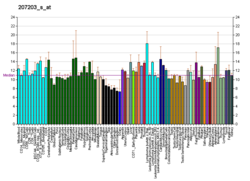プレグナンX受容体
プレグナンX受容体(プレグナンXじゅようたい、英: pregnane X receptor、略称: PXR)は、ヒトではNR1I2遺伝子によってコードされるタンパク質である。SXR(steroid and xenobiotic sensing nuclear receptor)、NR1I2(nuclear receptor subfamily 1, group I, member 2)の名称でも知られる。
機能
PXRは核内受容体であり、その主な機能は外来の毒性物質を検知し、それに応答してこうした物質の解毒と体外への除去に関与するタンパク質の発現をアップレギュレーションすることである。PXRは核内受容体スーパーファミリーに属し、このファミリーのメンバーはリガンド結合ドメインとDNA結合ドメインを持つことで特徴づけられる転写因子である。PXRはシトクロムP450遺伝子CYP3A4の転写調節因子であり、9-cis-レチノイン酸受容体であるRXRとのヘテロ二量体としてCYP3A4のプロモーターに結合する。デキサメタゾンやリファンピシンなど、CYP3A4を誘導するさまざまな化合物によって活性化される。
リガンド
アゴニスト
PXRはステロイド(プロゲステロン、17α-ヒドロキシプロゲステロン、17α-ヒドロキシプレグネノロン、5α-ジヒドロプロゲステロン、5β-ジヒドロプロゲステロン、アロプレグナノロン、コルチコステロン、酢酸シプロテロン、スピロノラクトン、デキサメタゾン、ミフェプリストンなど)、抗生物質(リファンピシン、リファキシミンなど)、抗真菌薬、胆汁酸、ヒペルフォリン(セント・ジョーンズ・ワート(セイヨウオトギリ)の成分)、メクリジン、パクリタキセル、カフェストール、フォルスコリンなど、多数の内因性・外因性の化学物質によって活性化される。
アンタゴニスト
ケトコナゾールは、PXRのアンタゴニストとして知られている数少ない例の1つである。SPA70(LC-1)は近年同定され、PXRの強力かつ選択的なアンタゴニストとして特性解析がなされた。
機構
他のII型核内受容体と同様、活性化された際にはレチノイドX受容体とヘテロ二量体を形成し、ホルモン応答エレメント(hormone response element, HRE)に結合して遺伝子の発現を誘導する。
PXRの活性化の主要な標的はCYP3A4の誘導である。CYP3A4は多くの薬物の代謝の第I相を担う重要な酸化酵素である。さらに、PXRはグルタチオン-S-トランスフェラーゼなど第II相の抱合反応を担う酵素や、OATP2、MDR1など第III相の排出に関与するタンパク質もアップレギュレーションする。
関連文献
- “Structural insights into the promiscuity and function of the human pregnane X receptor”. Current Opinion in Drug Discovery & Development 5 (1): 150–8. (January 2002). PMID 11865669.
- “Oligo-capping: a simple method to replace the cap structure of eukaryotic mRNAs with oligoribonucleotides”. Gene 138 (1–2): 171–4. (January 1994). doi:10.1016/0378-1119(94)90802-8. PMID 8125298.
- “Construction and characterization of a full length-enriched and a 5'-end-enriched cDNA library”. Gene 200 (1–2): 149–56. (October 1997). doi:10.1016/S0378-1119(97)00411-3. PMID 9373149.
- “An orphan nuclear receptor activated by pregnanes defines a novel steroid signaling pathway”. Cell 92 (1): 73–82. (January 1998). doi:10.1016/S0092-8674(00)80900-9. PMID 9489701.
- “The human orphan nuclear receptor PXR is activated by compounds that regulate CYP3A4 gene expression and cause drug interactions”. The Journal of Clinical Investigation 102 (5): 1016–23. (September 1998). doi:10.1172/JCI3703. PMC 508967. PMID 9727070. https://www.ncbi.nlm.nih.gov/pmc/articles/PMC508967/.
- “Identification of a human nuclear receptor defines a new signaling pathway for CYP3A induction”. Proceedings of the National Academy of Sciences of the United States of America 95 (21): 12208–13. (October 1998). Bibcode: 1998PNAS...9512208B. doi:10.1073/pnas.95.21.12208. PMC 22810. PMID 9770465. https://www.ncbi.nlm.nih.gov/pmc/articles/PMC22810/.
- “SXR, a novel steroid and xenobiotic-sensing nuclear receptor”. Genes & Development 12 (20): 3195–205. (October 1998). doi:10.1101/gad.12.20.3195. PMC 317212. PMID 9784494. https://www.ncbi.nlm.nih.gov/pmc/articles/PMC317212/.
- “The human orphan receptor PXR messenger RNA is expressed in both normal and neoplastic breast tissue”. Clinical Cancer Research 5 (8): 2103–7. (August 1999). PMID 10473093.
- “Nuclear receptor response elements mediate induction of intestinal MDR1 by rifampin”. The Journal of Biological Chemistry 276 (18): 14581–7. (May 2001). doi:10.1074/jbc.M010173200. PMID 11297522.
- “The human nuclear xenobiotic receptor PXR: structural determinants of directed promiscuity”. Science 292 (5525): 2329–33. (June 2001). doi:10.1126/science.1060762. PMID 11408620.
- “The human pregnane X receptor: genomic structure and identification and functional characterization of natural allelic variants”. Pharmacogenetics 11 (7): 555–72. (October 2001). doi:10.1097/00008571-200110000-00003. PMID 11668216.
- “Cross-repression, a functional consequence of the physical interaction of non-liganded nuclear receptors and POU domain transcription factors”. The Journal of Biological Chemistry 277 (21): 18501–9. (May 2002). doi:10.1074/jbc.M200205200. PMID 11891224.
- “Putative role of the orphan nuclear receptor SXR (steroid and xenobiotic receptor) in the mechanism of CYP3A4 inhibition by xenobiotics”. The Journal of Biological Chemistry 277 (36): 32453–8. (September 2002). doi:10.1074/jbc.M111245200. PMID 12072427.
- “Proliferative action of mast-cell tryptase is mediated by PAR2, COX2, prostaglandins, and PPARgamma : Possible relevance to human fibrotic disorders”. Proceedings of the National Academy of Sciences of the United States of America 99 (23): 15072–7. (November 2002). Bibcode: 2002PNAS...9915072F. doi:10.1073/pnas.232422999. PMC 137545. PMID 12397176. https://www.ncbi.nlm.nih.gov/pmc/articles/PMC137545/.
- “Identification of the novel splicing variants for the hPXR in human livers”. Biochemical and Biophysical Research Communications 298 (3): 433–8. (November 2002). doi:10.1016/S0006-291X(02)02469-5. PMID 12413960.
- “Constitutive androstane receptor and pregnane X receptor gene expression in human liver: interindividual variability and correlation with CYP2B6 mRNA levels”. Drug Metabolism and Disposition 31 (1): 7–10. (January 2003). doi:10.1124/dmd.31.1.7. PMID 12485946.
- “Identification of an endogenous ligand that activates pregnane X receptor-mediated sterol clearance”. Proceedings of the National Academy of Sciences of the United States of America 100 (3): 833–8. (February 2003). Bibcode: 2003PNAS..100..833D. doi:10.1073/pnas.0336235100. PMC 298687. PMID 12569201. https://www.ncbi.nlm.nih.gov/pmc/articles/PMC298687/.
- “Molecular mechanism of nuclear translocation of an orphan nuclear receptor, SXR”. Molecular Pharmacology 63 (3): 524–31. (March 2003). doi:10.1124/mol.63.3.524. PMID 12606758.







